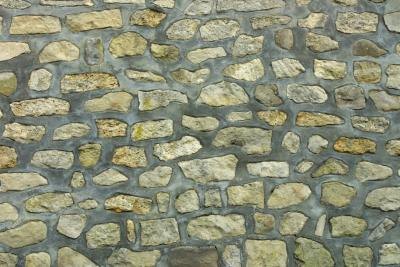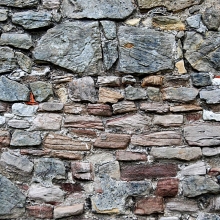Evolution of Stone Construction Form
Dry Stone Stacking
Dry stone stacking the earliest form of stone construction. These are free standing structures such as long distance field walls and bridges. Stones with irregular shapes are carefully selected and placed so that they hold each others closely and tightly together without slipping. Furthermore, as height increases structures which possess wider base are needed. Plus, the support of structure is originated from the weight of the stone which tends to push inwards, and settling makes the structure lock tightly together and become more stable and stronger. Dry stone structures have high durability. Moreover, dry stone structures do not need frequent maintenance as they allow water to drain through them, without causing damage to the stones. In addition, this form of stone construction do not require any special equipments, only the skill and technique of the craftsman in selecting and placing the stones.
Stone Masonry
Traditional stone masonry is the evolution form of stone construction of dry stone stacking. Stone blocks are placed in rows evenly (courses) or unevenly (uncoursed) height, and hold together tightly with the addition of mortar, a cement or lime mixture between the stones. The building stones are conventionally extracted by surface quarrying, drilled and split using diamond saws or iron wedges, and then shaped and polished according to their requirements. The basic hand equipments used to shape stones are chisels, mallet and a metal straight edge, but modern power tools such as angle grinders and compressed air-chisels are often used to save time and money. Plus, stones are either shaped into a block, known as ashlar masonry, or left rough and cut irregularly, known as rubble masonry. However, mortared stone structures have lower durability than dry stone structures, because water can easily get trapped between the stones and push them apart.
Stone Cladding
Nowadays, traditional stone masonry is rarely used because stone is rather expensive to quarry, cut and transport, and the building process is labour and skill-intensive. Instead, most modern stonework utilises a veneer of stone (thin, flat pieces) glued against a wall of concrete blocks. This is known as veneered stone or stone cladding.
Slip Form Stone Structure
 Slip form stone structures are a combination between veneered masonry and traditional masonry. Short forms (around 2 feet tall) are placed on either side of the wall, to act as a guide for the structure. Stones are placed inside the forms with the flat face out, and concrete is then poured behind the rocks to hold it together. Stone buildings can be constructed swiftly and easily with this method.
Slip form stone structures are a combination between veneered masonry and traditional masonry. Short forms (around 2 feet tall) are placed on either side of the wall, to act as a guide for the structure. Stones are placed inside the forms with the flat face out, and concrete is then poured behind the rocks to hold it together. Stone buildings can be constructed swiftly and easily with this method. via Sustainablebuild~
via Sustainablebuild~



GẠCH NHẸ KHÔNG NUNG
ReplyDeletenice post!Có nên xây nhà bằng bê tông siêu nhẹ,Gạch nhẹ không nung chất lượng cao.
ReplyDeleteGạch nhẹ không nung chất lượng cao,
ReplyDeleteƯU ĐIỂM VÀ NHƯỢC ĐIỂM GẠCH KHÔNG NUNG TRONG XÂY DỰNG.
Nhà Khung Thép giá rẻ
Gạch nhẹ không nung chất lượng cao,
ReplyDeleteƯU ĐIỂM VÀ NHƯỢC ĐIỂM GẠCH KHÔNG NUNG TRONG XÂY DỰNG.
Nhà Khung Thép giá rẻ
ƯU ĐIỂM VÀ NHƯỢC ĐIỂM GẠCH KHÔNG NUNG TRONG XÂY DỰNG, GẠCH NHẸ KHÔNG NUNGƯU ĐIỂM VÀ NHƯỢC ĐIỂM GẠCH KHÔNG NUNG TRONG XÂY DỰNG, GẠCH NHẸ KHÔNG NUNGƯU ĐIỂM VÀ NHƯỢC ĐIỂM GẠCH KHÔNG NUNG TRONG XÂY DỰNG, GẠCH NHẸ KHÔNG NUNG
ReplyDeleteNhà thép khung thép 2 tầng – Xu hướng làm nhà ở mới hiện nay, Ưu điểm gạch không nung trong xây dựng,Gạch nhẹ không nung chất lượng cao.
ReplyDeleteGiá nhà khung thép
ReplyDeleteSo sánh gạch nung và gạch không nung
Nha khung thep 2 tang
I want to share a testimony on how Le_Meridian funding service helped me with loan of 2,000,000.00 USD to finance my marijuana farm project , I'm very grateful and i promised to share this legit funding company to anyone looking for way to expand his or her business project.the company is funding company. Anyone seeking for finance support should contact them on lfdsloans@outlook.com Or lfdsloans@lemeridianfds.com Mr Benjamin is also on whatsapp 1-989-394-3740 to make things easy for any applicant.
ReplyDeleteThanks for sharing these ideas about using marble in interior design.
ReplyDeleteTraditional stone masonry Austria
Natural stone craftsmanship Vienna
Historic building restoration Austria
Custom stone carving Austria
Architectural stone detailing Austria
Stonemasonry workshops Austria
Granite and marble masonry Austria
Stone façade restoration Austria
Handcrafted stone monuments Austria
Cultural heritage masonry Austria